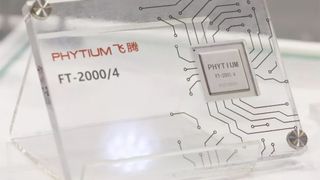This Chinese CPU challenger is taking on Intel and AMD with Arm's help
Chinese server chip designer goes after Intel’s low-power CPUs with FT-2000/4

Phytium is not exactly a household name, but avid readers remember that this company was among the first to announce a 64-core ARMv8 processor for servers several years ago.
Last year the firm introduced a new 64-core FT-2000/4 CPU for HPC machines, but its interests appear to extend to client PCs too. At an event in China, Phytium showcased its all-new FT-2000/4 processor for low-power clients.
The Phytium FT-2000/4 processor packs four internally-developed FTC663 cores clocked at up to 2.6 GHz and based on the company’s latest ARMv8 microarchitecture featuring a four-issue out-of-order pipeline, new INT and FP units as well as a revamped dynamic branch predictor. The CPU supports ASIMD instructions, hardware-assisted virtualization along with proprietary security capabilities.
- Best laptops under $200: the best budget laptops around
- Best laptops for kids: the top laptops for kids in elementary school and beyond
- How to switch to a new laptop in under 30 minutes
Low-Power Brother
Pythium’s FT-2000-4 processor has not been formally introduced so far, but as its name suggests, it derives from last year’s FT-2000/64 designed primarily for HPC servers. The 64-core powerhouse runs at 2.2 GHz – 2.4 GHz, it features 32 MB of L2 cache (i.e., 512 KB per core), eight DDR4 memory channels, 33 PCIe Gen 3 lanes, and a TDP of around 90 W. The SoC is produced using TSMC’s 16 nm process technology.
Considering a lower number of cores when compared to its older brother, the FT-2000/4 probably sports a dual-channel memory controller and has a considerably lower TDP of around 10 W. Low power consumption of the CPU allow it to compete against inexpensive processors from AMD and Intel for low-power/small form-factor desktops as well as notebooks.
Unfortunately, there is no information about performance of Phytium’s FT2000/4 processor and how does it stack against AMD’s Ryzen and Intel’s Core CPUs in general-purpose applications.
Pythium’s latest CPUs are already used inside desktop PCs for China that run a locally developed operating system.
Are you a pro? Subscribe to our newsletter
Sign up to the TechRadar Pro newsletter to get all the top news, opinion, features and guidance your business needs to succeed!
Via HKEPC
Anton Shilov is the News Editor at AnandTech, Inc. For more than four years, he has been writing for magazines and websites such as AnandTech, TechRadar, Tom's Guide, Kit Guru, EE Times, Tech & Learning, EE Times Asia, Design & Reuse.
Most Popular

